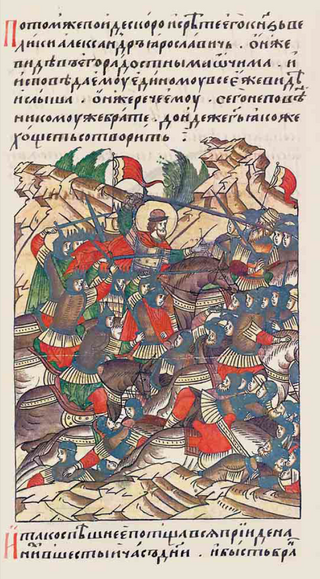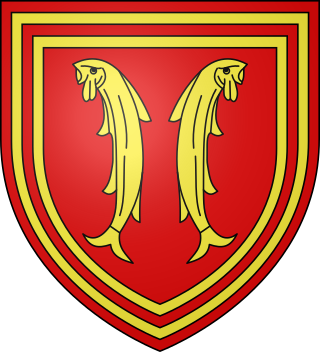
The Kingdom of Jerusalem, also known as the Latin Kingdom, was a Crusader state that was established in the Levant immediately after the First Crusade. It lasted for almost two hundred years, from the accession of Godfrey of Bouillon in 1099 until the fall of Acre in 1291. Its history is divided into two periods with a brief interruption in its existence, beginning with its collapse after the siege of Jerusalem in 1187 and its restoration after the Third Crusade in 1192.

Year 1248 (MCCXLVIII) was a leap year starting on Wednesday of the Julian calendar.
The 1240s was a decade of the Julian Calendar which began on January 1, 1240, and ended on December 31, 1249.

Year 1240 (MCCXL) was a leap year starting on Sunday of the Julian calendar.

Year 1247 (MCCXLVII) was a common year starting on Tuesday of the Julian calendar.

Year 1249 (MCCXLIX) was a common year starting on Friday of the Julian calendar.

The Eighth Crusade was the second Crusade launched by Louis IX of France, this one against the Hafsid dynasty in Tunisia in 1270. It is also known as the Crusade of Louis IX Against Tunis or the Second Crusade of Louis. The Crusade did not see any significant fighting as Louis died of dysentery shortly after arriving on the shores of Tunisia. The Treaty of Tunis was negotiated between the Crusaders and the Hafsids. No changes in territory occurred, though there were commercial and some political rights granted to the Christians. The Crusaders withdrew back to Europe soon after.

The Ayyubid dynasty, also known as the Ayyubid Sultanate, was the founding dynasty of the medieval Sultanate of Egypt established by Saladin in 1171, following his abolition of the Fatimid Caliphate of Egypt. A Sunni Muslim of Kurdish origin, Saladin had originally served the Zengid ruler Nur ad-Din, leading Nur ad-Din's army in battle against the Crusaders in Fatimid Egypt, where he was made Vizier. Following Nur ad-Din's death, Saladin was proclaimed as the first Sultan of Egypt by the Abbasid Caliphate, and rapidly expanded the new sultanate beyond the frontiers of Egypt to encompass most of the Levant, in addition to Hijaz, Yemen, northern Nubia, Tarabulus, Cyrenaica, southern Anatolia, and northern Iraq, the homeland of his Kurdish family. By virtue of his sultanate including Hijaz, the location of the Islamic holy cities of Mecca and Medina, he was the first ruler to be hailed as the Custodian of the Two Holy Mosques, a title that would be held by all subsequent sultans of Egypt until the Ottoman conquest of 1517. Saladin's military campaigns in the first decade of his rule, aimed at uniting the various Arab and Muslim states in the region against the Crusaders, set the general borders and sphere of influence of the sultanate of Egypt for the almost three and a half centuries of its existence. Most of the Crusader states, including the Kingdom of Jerusalem, fell to Saladin after his victory at the Battle of Hattin in 1187. However, the Crusaders reconquered the coast of Palestine in the 1190s.

The Seventh Crusade (1248–1254) was the first of the two Crusades led by Louis IX of France. Also known as the Crusade of Louis IX to the Holy Land, it aimed to reclaim the Holy Land by attacking Egypt, the main seat of Muslim power in the Near East. The Crusade was conducted in response to setbacks in the Kingdom of Jerusalem, beginning with the loss of the Holy City in 1244, and was preached by Innocent IV in conjunction with a crusade against emperor Frederick II, Baltic rebellions and Mongol incursions. After initial success, the crusade ended in defeat, with most of the army – including the king – captured by the Muslims.

The Battle of Forbie, also known as the Battle of La Forbie or the Battle of Hiribya, was fought October 17, 1244 – October 18, 1244 between the allied armies and the Egyptian army of the Ayyubid Sultan as-Salih Ayyub, reinforced with Khwarezmian mercenaries. The resulting Ayyubid victory led to the call for the Seventh Crusade and marked the collapse of Christian power in the Holy Land.

The siege of Ascalon took place in 1153, resulting in the capture of that Egyptian fortress by the Kingdom of Jerusalem.

The Crusades were a series of religious wars initiated, supported, and sometimes directed by the Christian Latin Church in the medieval period. The best known of these military expeditions are those to the Holy Land in the period between 1095 and 1291 that were intended to reconquer Jerusalem and its surrounding area from Muslim rule after it had been taken by force centuries earlier. Beginning with the First Crusade, which resulted in the conquest of Jerusalem in 1099, dozens of military campaigns were organised, providing a focal point of European history for centuries. Crusading declined rapidly after the 15th century.

An-Nasir Dawud (1206–1261) was a Kurdish ruler, briefly (1227–1229) Ayyubid sultan of Damascus and later (1229–1248) Emir of Al-Karak.

Odo of Montbéliard was a leading baron of the crusader Kingdom of Jerusalem in the early 13th century. He often held the highest offices in the kingdom including bailli (viceroy) and constable.
Al Malik Al-Mujahid Asad ad-Din Shirkuh II was the Kurdish Ayyubid emir of Homs from 1186 to 1240. He was the son of An-Nasir Muhammad ibn Shirkuh, grandson of Shirkuh and first cousin once removed of Saladin. His domains also included Palmyra and ar-Rahba. Al Mujahid became emir at the age of thirteen when his father died unexpectedly in Homs on 4 March 1186.
Al-Muzaffar II Mahmud was the Ayyubid emir of Hama first in 1219 and then restored in 1229–1244. He was the son of al-Mansur Muhammad and the older brother of al-Nasir Kilij Arslan.

The Barons' Crusade (1239–1241), also called the Crusade of 1239, was a crusade to the Holy Land that, in territorial terms, was the most successful crusade since the First Crusade. Called by Pope Gregory IX, the Barons' Crusade broadly embodied the highest point of papal endeavor "to make crusading a universal Christian undertaking." Gregory IX called for a crusade in France, England, and Hungary with different degrees of success. Although the crusaders did not achieve any glorious military victories, they used diplomacy to successfully play the two warring factions of the Ayyubid dynasty against one another for even more concessions than Frederick II had gained during the more well-known Sixth Crusade. For a few years, the Barons' Crusade returned the Kingdom of Jerusalem to its largest size since 1187.
Fakhr al-Din ibn al-Shaykh was an Egyptian emir of the Ayyubid dynasty. He served as a diplomat for sultan al-Kamil from 1226 to 1228 in his negotiations with the Holy Roman Emperor Frederick II leading to the end of the Sixth Crusade. He later commanded forces during the Seventh Crusade, dying at the Battle of al-Mansura in 1250.

The Battle at Gaza took place on 13 November 1239 as part of the Barons' Crusade. In it, an army led by Theobald I of Navarre was defeated by the Egyptian Ayyubids.
Jean de Ronay was knight of the Order of Saint John of Jerusalem who was appointed Grand Commander of the Knights Hospitaller by the Grand Master Guillaume de Chateauneuf in 1243 or 1244. He served as interim Grand Master of the Knights Hospitaller from 1244 to 1250 during the captivity of de Chateauneuf. He died in battle during the Seventh Crusade.














